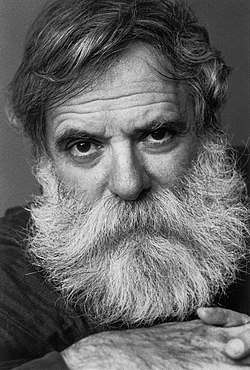Micha Bar-Am
Micha Bar-Am (Hebrew: מיכה בר-עם) (born 1930) is a German-born Israeli journalistic photographer. His images cover every aspect of life in Israel in the past sixty years.

Since 1968 he has been a correspondent with Magnum, the photographic cooperative. From 1968 to 1992, he was The New York Times photographic correspondent from Israel. He has published several books of photography, beginning in 1957. His work is held in numerous international museums and institutes throughout the world.
Early life
Born in Berlin to a Jewish family, Bar-Am moved with his parents in 1936 to then British Mandate of Palestine. He attended local schools.
He was drafted in 1948 and served during the Israeli War of Independence, when he was part of the Palmach Unit. Afterward, he worked several jobs, including as a locksmith and a mounted guard, before becoming a photographer. In 1949 he co-founded the kibbutz Malkia in Galilee. Later he became a member of Kibbutz Gesher HaZiv.[1]
Photography career
In the early 1940s, Bar-Am started taking pictures of life on a kibbutz; he used borrowed cameras until he bought a Leica. After his military service, he began photographing more seriously.
After publishing his first book, Across Sinai (1957), Bar-Am gained work as a photographic reporter and in the editorial staff of the Israeli Army magazine, Ba-Mahaneh, from 1957 to 1967. In 1961 he covered the Eichmann trial.
In 1967 he covered the Six-Day War, during which time he met Cornell Capa. Many of his war images brought him renown. Since 1968, he has been a correspondent for Magnum Photos. In 1974 he helped Capa found the International Center of Photography in New York City.
In 1968, Bar-Am also became the photographic correspondent from Israel for The New York Times, a position he held until 1992. From 1977 to 1992, he was head of the department of photography at the Tel Aviv Museum of Art.
He continues to work on his photography. He writes about his work:
"I keep my internal eye open for that other, metaphorical image that transcends illustration to achieve a wholeness of its own. I strive for the elusive entity that is both evidence and evocation, public record and personal vision."
He says that he has adopted Robert Capa's saying, "If your photographs aren't good enough, you weren't close enough," but has added a caveat:
"If you're too close you lose perspective. It is not easy to be fair with the facts and keep your own convictions out of the picture. It is almost impossible to be both a participant in the events and their observer, witness, interpreter. The effort brings great frustration, and equally great reward." [1]
Personal life
Bar-Am is married to Orna, an artist. Together they have three sons.
Awards
- 1985--Fulbright Grant
- 1985—Golden Flamingo Award for Photographic Poster, Arles, France
- 1985—IBM Fellowship, Aspen, Colorado, USA
- 1985-86--Nieman Fellow, Harvard University, Cambridge, Massachusetts, USA
- 1993—Enrique Kavlin Prize, Israel Museum, Jerusalem, Israel
- 2000--Israel Prize for photography.[2][3]
Books
- Across Sinai, Israel: Hakibbutz Hameuhad, 1957
- Portrait of Israel, USA: New York Times/American Heritage Press, 1970
- The Jordan, Israel: Massada Ltd., 1981
- Jewish Sites in Lebanon, USA: Moreshet Erets-Yisrael/Ariel, 1984
- Painting With Light: The Photographic Aspect in the Work of E.M. Lilian, Israel: Tel Aviv Museum of Art/Dvir Publishing, 1991
- The Last War, Israel: Keter Publishers, 1996
- Israel: A Photobiography, USA: Simon & Schuster, 1998
- Insight: Micha Bar-Am's Israel, London: Koenig Books / Israel: Open Museums, 2011
- Southward: Micha Bar-Am, Photographs, Israel: The Negev Museum of Art, 2013
Collections
- Israel Museum, Jerusalem, Israel
- Tel Aviv Museum of Art, Tel Aviv, Israel
- Haifa Museum, Haifa, Israel
- The Museum of the Jewish People at Beit Hatfutsot, Tel Aviv, Israel
- The Museum of Photography at Tel Hai, Tel Hai Kibbutz, Israel
- International Center of Photography, New York, USA
- The Museum of Modern Art, New York, USA
- Museum of Fine Arts, Houston, USA
- International Museum of Photography at George Eastman House, Rochester, USA
- Skirball Museum, Los Angeles, USA
- Minneapolis Institute of Arts, Minneapolis, USA
- Henry Buhl Collection, New York, USA
- Ludwig Museum, Cologne, Germany
- Folkwang Museum, Essen, Germany
- Bibliothèque Nationale, Paris, France
- Musée d'Art et d'Histoire du Judaïsme, Paris, France
- Collection FNAC, Paris, France
- Fundacion “La Caixa”, Barcelona, Spain
- National Maritime Museum, London, UK
- Magnum Photos: Photographic Collection, Harry Ransom Center, University of Texas at Austin, USA
See also
References
External links
- Micha Baram - homepage
- International Center of Photography (ICP), Micha Bar-Am: Biography. By Kaitlin Vaughan
- biography and portfolio at Ultimate Art Gallery
- Bar-Am About the Photographers
- Magnum biography
- Micha Bar-Am in the Collection of The Jewish Museum (New York)
- "Southward" exhibition at the Negev Museum of Art. Jerusalem Post, 14 April 2013